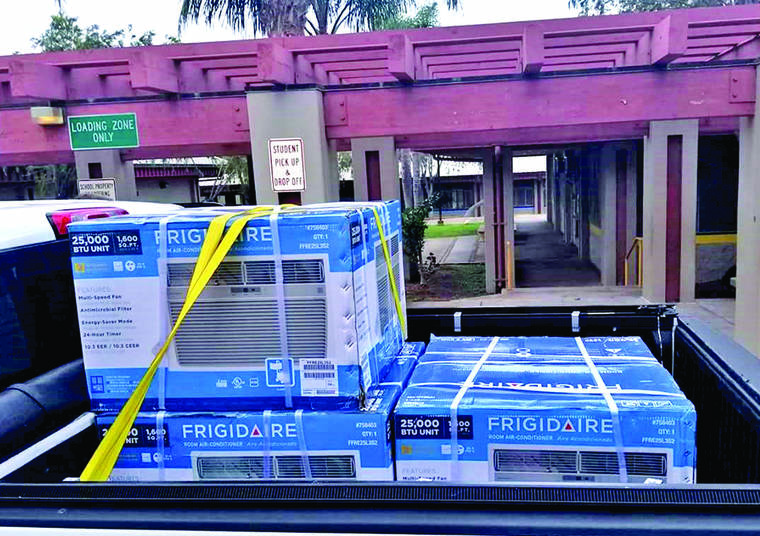Cooling down: Big Island schools working on bringing more AC units into classrooms
KAILUA-KONA — Big Island educators looking to cool down their students this year have a new way to bring air conditioner units into their overheated classrooms.
The state Department of Education announced last week the Schools Directed AC (SDAC) program will give schools across the state the power to kick-start the process of bringing AC units into their classrooms.
ADVERTISING
Under the program, school leaders can request an official electrical assessment from the DOE’s Office of Facilities and Operation to determine if there is enough electrical capacity to install AC window units in their classrooms.
Corey Rosenlee knows the effects lack of AC can have on students in Hawaii schools. Rosenlee was a social studies teacher at James Campbell High School on Oahu before he became president of the Hawaii State Teachers Association.
“Most of the classrooms before we started this initiative years ago did not have AC in the classrooms. A lot of classrooms, my own classroom for example, could get over 90 degrees, sometimes even 100 degrees in a classroom,” Rosenlee said. “When you put 40 kids in a room, it was unbearable. Forget trying to be a conducive learning environment, it was so hot you couldn’t focus on anything.
“A couple years ago I was in Keaau on the Hilo side, and the humidity was just so unbearable. The classrooms there were very much in need of having a cool learning environment.”
Bringing in AC units to Big Island schools can help with more than just the heat, too.
“Four years ago, we had $100 million to install air conditioning, and that got 1,300 classrooms, but a lot of the schools on the Big Island, especially after the volcano, they needed the air conditioning not just to cool rooms down but to deal with the smog,” Rosenlee said. “And last year when the volcano was erupting, I was out in Pahoa and you could definitely tell that not being able to close the windows was not beneficial.”
The $100 million for AC installation in schools was from Senate Bill 3126, signed by Gov. David Ige in 2016.
Nanea Kalani, communications specialist for the DOE, said in an email that teachers and administrators can initiate bringing AC units into their schools by contacting the department directly for an assessment, and then by reaching out to the community and lawmakers to help with costs.
“Under the SDAC program, the Department will work with schools to cover technical assessments and will advise which buildings have the electrical capacity to support AC and how many units can be installed,” Kalani said. “Schools can then make arrangements to procure and install units using school funds or by partnering with community groups to fundraise or engaging their area lawmakers.”
Kalani said estimated costs for a classroom or school to install an AC unit varies on a case-by-case basis.
“There are many factors that determine cooling costs, from electrical upgrades that may be required, to installation and wiring, as well as the AC equipment itself,” Kalani said. “Equipment could be donated by community or parent groups and labor could also be donated by volunteers who are licensed. For equipment, the Department recommends two energy-efficient 2-ton (24,000 BTU) window units for a typical 900-square-foot classroom.”
Rosenlee said the DOE allowing classrooms to install window AC units lowers the cost for schools.
“The cost is an average of $8,000, but most of that cost is to hire a licensed electrician,” Rosenlee said. “Some of schools have reached out to parents, community groups or contractors in the area so they don’t need to hire a licensed electrician. They can find someone to donate their time, and once you do that, it can be a couple hundred to maybe a couple thousand dollars to bring one to a classroom.”
The DOE stated in a press release about 6,200 out of 11,000 DOE classrooms in the state are currently air conditioned.
The Big Island schools that have either had an electrical assessment completed by the DOE under SDAC or have requested an assessment are: Hilo Union Elementary, Haaheo Elementary, Waiakea Elementary, Keonepoko Elementary, Kapiolani Elementary, Waikoloa Elementary, Holualoa Elementary, Waikoloa Middle, Kealakehe Intermediate, Waiakea Intermediate, Hilo Intermediate, Hilo High, and Kealakehe High.
Three schools on the Big Island have installed energy-efficient air conditioning units under the SDAC program: Hilo Union Elementary, Mountain View Elementary and Keaau Middle School.
According to HSTA and Rosenlee, one of the easiest ways to make sure a school has the electrical capacity needed for AC units is to convert fluorescent light bulbs in the building to LED lights.
Rosenlee said about 50% of a school’s electrical capacity goes toward lighting.
“Most of our schools are on average 60 years old,” Rosenlee said. “So even if you bought an air conditioning unit, and wanted to install it, if you did that, it would blow out the circuitry of the school and that’s why ACs were not allowed in the schools. So by going from the fluorescent lights to the LED lights, it dramatically opens up the capacity of school.”
HSTA said in a press release converting to LED light bulbs can reduce energy use in classrooms by 62%, freeing up electrical capacity that can be used to run AC units.
All 171 public schools on Oahu have made the switch to LED lights, and 51 out of 93 schools on other islands had converted as of early August.
Rosenlee said classrooms that install AC will be able to see an immediate positive change to the students and learning environment.





